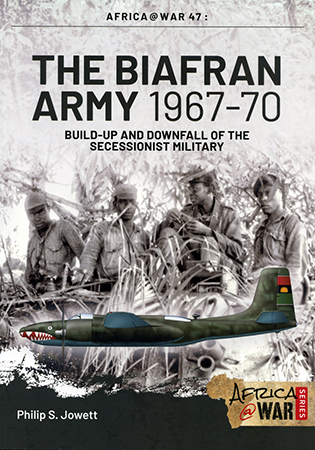
The Biafran Army 1967-70 Book Review
By David L. Veres
| Date of Review | July 2020 | Title | The Biafran Army 1967-70 |
|---|---|---|---|
| Author | Philip Jowett | Publisher | Helion |
| Published | 2020 | ISBN | 9781911628637 |
| Format | 88 pages, hardbound | MSRP (USD) | $29.95 |
Review
The subtitle says it all.
“Build-Up and Downfall of the Secessionist Military” succinctly summarizes Philip Jowett’s The Biafran Army 1967-70 – 47th in Helion’s landmark “Africa @ War” series.
His brief book chronicles the total tale in seven chapters over just 88 picture-packed pages:
- Establishment of the Biafran Armed Forces
- Biafran Army at War
- Mercenaries in Biarfa
- Weaponry of the Biafran Army
- Combat Operations of the Biafran War
- Biafra’s Naval and Air War
- Biafran Military Equipment and Gear
Metaphorical mounds of mind-numbing minutiae – both consequential and quotidian – season Jowett’s intriguing account.
Seeking details of training? Look here. How about uniform insignia? That, too. Background history? Definitely. Warplane colors and camouflage? Paint that model!
Jowett’s lavishly illustrated effort sports dozens of rare photos – including two pages of color shots. Maps put actions into geographic perspectives. And 18 color plates – seven military vehicles by David Bocquelet, seven aircraft by Tom Cooper, and four uniforms by Anderson Subtil – provide potent project potential.
Unfortunately, I frequently found myself mentally editing text for superfluous and redundant comments.
How many times in the first 20 pages must Jowett remind readers that Biafran recruits lacked training weapons?
And while some annotations support sections, the sheer number of unsubstantiated quotes, counts, claims, and conclusions bluntly proved troubling.
Which source(s), for instance, provided detailed Biafran officer totals on page 14? And why does Jowett’s chapter on Biafran naval and air operations completely lack endnotes?
Watch for elementary errors, too. Congo didn’t become “DR Congo” until 1997 – over 25 years after Biafra’s demise. That’s “President [Joseph] Kasavubu” – not “Kasavumba”. And who missed all those basic grammar goofs?
Extended, explanatory captions and lists of solely secondary, English-language sources conclude contents.
On balance, I enjoyed The Biafran Army 1967-70. Given the dearth of trusty official and anecdotal sources on Biafra’s struggle, many readers will probably find it a handy introduction to this tragic topic.
With thanks to Casemate Publishing for the review copy!







